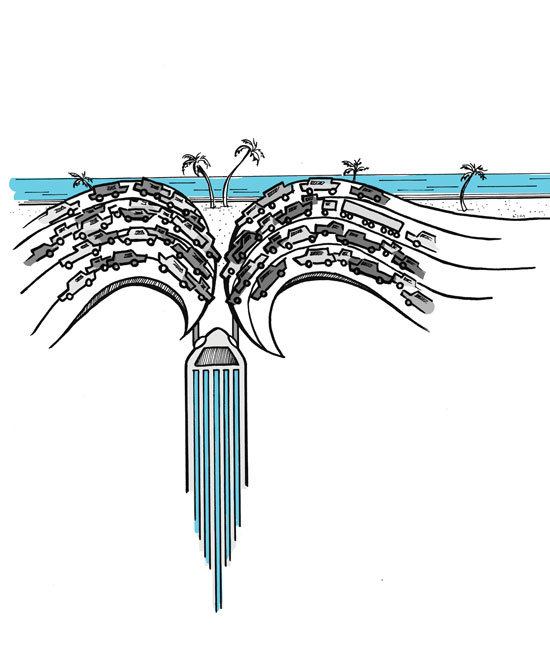LA transport system, Westside subway, long overdue

By Lina Chung
Oct. 25, 2009 9:00 p.m.
Last week, in a remarkable move toward ending Los Angeles’ traffic plague, L.A. County officials approved a 30-year transportation plan for an estimated $300 billion, which includes arrangements for a Westside subway.
Although this plan faced initial challenges from critics, the Westside subway is a necessary and forward-thinking economic investment to alleviate this city’s overburdened traffic woes. This plan is a necessary change that has been long overdue for a city the size and scope of Los Angeles. And, it will be an efficient addition to life on the Westside for UCLA students, faculty and neighboring residents and employees.
Proposed by the Los Angeles County Metropolitan Transit Authority and backed by Mayor Antonio Villaraigosa, the plan establishes the Westside subway and rail connection through downtown Los Angeles as top priorities for federal funding. It also provides provisions for other projects, such as lines in the San Gabriel Valley and South Los Angeles
And although this plan outlines admirably proactive goals, such as completing the West Los Angeles subway in as little as 10 years, it originally faced challenges from legislators who felt it would not bring immediate federal funding to Los Angeles Fourteen members of Southern California’s congressional delegation and eight state legislators demanded that the MTA add other projects to the proposal in order to compete for federal funding under the New Starts program.
The New Starts program is a part of the Federal Transit Administration and is designed to fund local transportation systems across the country as capital investments. And, since it is a source of transportation financial aid that is to be divided up across the nation, it is especially competitive during the current recession.
The critics’ demands included rail and line extensions for the San Gabriel Valley rather than the Westside. Critics felt that the Westside subway and downtown extensions weren’t broad enough goals to receive adequate New Starts money.
San Gabriel representatives wanted to include Pasadena’s Gold Line Foothill Extension and the second phase of Pasadena’s Gold Line Eastside Extension. Expansion of Pasadena’s Eastside line would include extending the current East Los Angeles line out to Monterey Park, down along either the 60 Freeway or down to Whittier.
Accordingly, an amendment was made to the plan so that other potential funding sources would be utilized to fund lines in the San Gabriel Valley and East Los Angeles. The current plan will be funded partially by New Starts federal money and partially from a sales tax increase approved by voters last year.
The sprawled layout of the city, as automobile executives and city planners originally conceived it, has formerly prevented Los Angeles from having a definite urban center as there is in San Francisco, Chicago or New York.
But, the Westside has long been a commercial and educational center for Angelenos. Building a subway on this part of town will not only help alleviate traffic, but it will also aid surrounding businesses that support the current undergraduate and graduate students at UCLA.
Therefore, West L.A. will transform into a “city center” of sorts, acting in the original role that downtown Los Angelesplayed during the pre-World War I era.
And, despite the fact that the Westside subway will be available, at the earliest, 10 years from now, the transportation system is a huge long-term investment for this car-dependent, public-transportation-deprived city.
As a lifetime Westside resident, I can attest to the frustrations of Los Angeles’s characteristic traffic ““ a five-minute commute home can easily morph into a 45-minute horrendous (and expensive, due to persistently stubborn gas prices) ordeal. Any student or faculty member is very familiar with the many hours spent staring at the nearby Getty Museum while sitting in stifling traffic on the 405.
We have all spent those agonizing moments cursing at a computer screen, praying for the Sigalert to deliver us a modern-day miracle by transforming those ugly red traffic routes into a gracious green.
And despite our best efforts to categorize a typical “rush hour” between the hours of 4 to 7 p.m., all Angelenos are fully aware that every hour is, indeed, “rush hour.”
Perhaps some might argue that the subway and transportation plan for the Westside and nearby areas is too little, too late.
But I am fully in support of the “better late than never” philosophy. Los Angeles’ history as a freeway-bound city, designed for the main benefit of automotive economics and car-dependence, has handicapped commuter transportation for far too long.
The Westside subway is estimated to alleviate traffic problems for an area of about 10 million people, with an additional three million residents predicted by 2040.
In order to further Los Angeles’ appeal as a cosmopolitan, modern and economical city, we have to adjust to the times and this city’s ever-growing population.
What the Westside subway can provide is a chance for UCLA students, and all other citizens of West Los Angeles, to explore the city and take advantage of its resources, without the aggravating distractions of Angeleno traffic.
E-mail Chung at [email protected]. Send general comments to [email protected].


